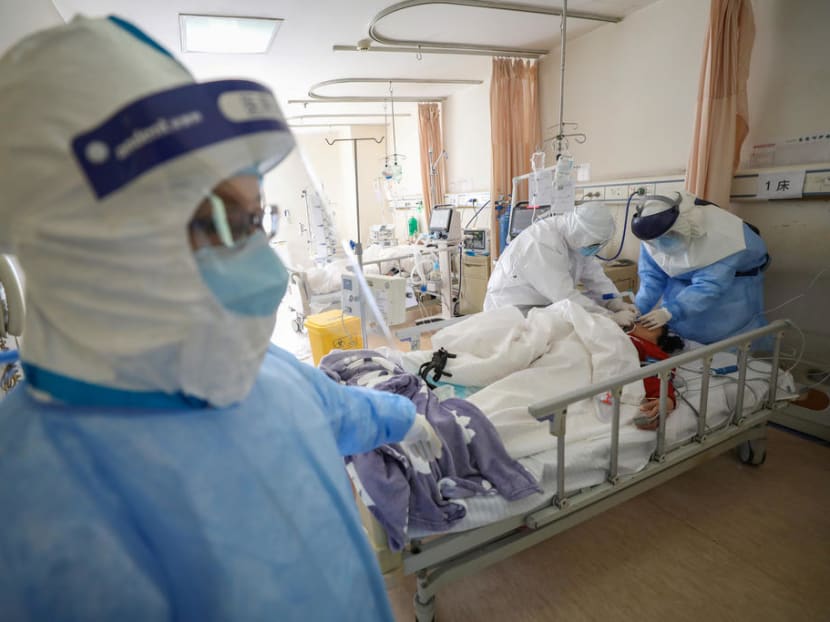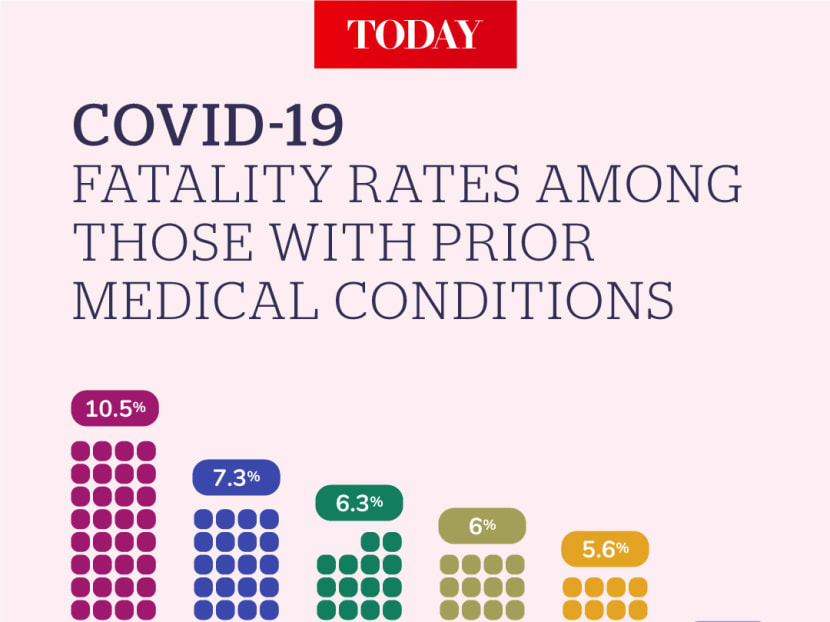Explainer: What the biggest study of Covid-19 patients tells us about who is most at risk
SINGAPORE — Most people infected with the Covid-19 virus in China have mild symptoms, but older patients with other health conditions are most at risk of severe complications, the largest study of patients infected with the virus has found.

Medical workers in protective suits attend to a patient inside an isolated ward of Wuhan Red Cross Hospital in Wuhan, Hubei province, China, Feb 16, 2020.
SINGAPORE — Most people infected with the Covid-19 virus in China have mild symptoms, but older patients with other health conditions are most at risk of severe complications, the largest study of patients infected with the virus has found.
The study, by Chinese researchers, also found that 81 per cent of all deaths among those infected with the virus were people aged 60 and over, and that the death rate among males was markedly higher at 2.8 per cent than among females, at 1.7 per cent.
The study, by the Chinese Centre for Disease Control and Prevention (CCDC), is the most extensive study of patients infected with the novel coronavirus since the outbreak began late last year.
It was published in the Chinese Journal of Epidemiology on Monday (Feb 17).
WHICH COVID-19 PATIENTS WERE STUDIED?
Researchers studied the patient records of 72,314 Covid-19 cases in China as of Feb 11, including confirmed cases, suspected cases, clinically diagnosed and asymptomatic cases.
The records were retrieved from China’s Infectious Disease Information System, where all cases of Covid-19 in China are entered.
Here is a breakdown of the cases studied:
44,672 (61.8 per cent) were confirmed cases, 16,186 (22.4 per cent) were suspected cases, 10,567 (14.6 per cent) were clinically diagnosed cases from Hubei province only and 889 (1.2 per cent) were asymptomatic cases.
Among the confirmed cases, 86.6 per cent were aged between 30 and 79.
80.9 per cent of confirmed cases were considered to have mild symptoms.
The Covid-19 virus spread to the rest of mainland China from Wuhan in Hubei province after December 2019. By Feb 11, 1,386 counties across all 31 provinces had been affected.
The epidemic curve, which shows the number of all cases plotted against the dates of the onset of symptoms for the patients, peaked in the period Jan 23 to 26 and began to decline in the lead up to Feb 11, the most recent date under study.
The study found that Covid-19 was more contagious than severe acute respiratory syndrome (Sars) and Middle East respiratory syndrome (Mers) but had significantly lower fatality rates than those conditions.
HOW BADLY HAVE HEALTH WORKERS BEEN AFFECTED?
A total of 1,716 health workers were infected and five had died as of Feb 11.
Most of the health workers who were confirmed cases in China were in Wuhan, accounting for 64 per cent of all the confirmed cases among health workers in China.
Separate to the study, news emerged on Wednesday that the director of a hospital in Wuhan, the epicentre of the outbreak, died on Tuesday.
Earlier this month, Wuhan ophthalmologist Li Wenliang, who alerted authorities to the outbreak but was questioned by police over “spreading rumours”, also died from the disease.
WHO IS MOST AT RISK OF DYING?
The study found that confirmed cases who were older, male and had other pre-existing health conditions had higher fatality rates.
A total of 1,023 patients confirmed to be infected with the virus had died as of Feb 11, which translates to a fatality rate of 2.3 per cent.
Those aged 80 and older had the highest fatality rate of 14.8 per cent.
By occupation, patients who were retirees had the highest fatality rate at about 5 per cent.
Patients with no other medical conditions had a low fatality rate of under 1 per cent.
But those with other health conditions had markedly higher fatality rates:
For cardiovascular disease, the fatality rate was 10.5 per cent,
For diabetes, the fatality rate was 7.3 per cent
For chronic respiratory disease, the fatality rate was 6.3 per cent
For hypertension, the fatality rate was 6 per cent
For cancer, the fatality rate was 5.6 per cent

Patients from Hubei province had a fatality rate of 2.9 per cent, which was more than seven times that of patients in other provinces (0.4 per cent).
In terms of age brackets, 30.2 per cent of deaths were patients aged 60 to 69, 30.5 per cent of deaths were those aged 70 to 79 and 20.3 per cent were those over 80 — which means 81 per cent of deaths were those aged 60 and above.
LIMITATIONS OF THE STUDY
Although a very large number of cases were analysed, the study had some important limitations, according to the paper.
Although all cases analysed were diagnosed clinically and investigated by trained epidemiologists, 37 per cent of the cases studied were not confirmed by nucleic acid testing, a type of test used to identify the virus.
This was because the process is slow, labour intensive, and requires specialised equipment and skilled technicians.
Some records also had missing data for a few important variables such as Wuhan-related exposure, comorbid conditions, and case severity.
The missing data limits the ability to derive conclusions from the dataset, the paper stated.
THE STUDY WARNS OF A POSSIBLE REBOUND
Researchers said that this study shows that the novel coronavirus had spread extremely rapidly despite extreme efforts to contain it.
They said questions remained over the virus including identifying the source of the animal reservoir, how the virus is transmitted and determining how long a patient is infectious.
More research is also needed for effective treatment and prevention methods such as further test, drug, and vaccine developments.
Although the epidemic appeared to be in decline in the lead up to Feb 11, the international community must prepare for “a possible rebound of the Covid-19 epidemic in the coming weeks and months”, as "huge numbers" of people return to work and school after the extended Chinese New Year holiday, the study said.
“As an international community, we must all be responsible partners in surveillance, communication, response, research, and implementation of evidence-based public health and clinical practice,” the study added.






